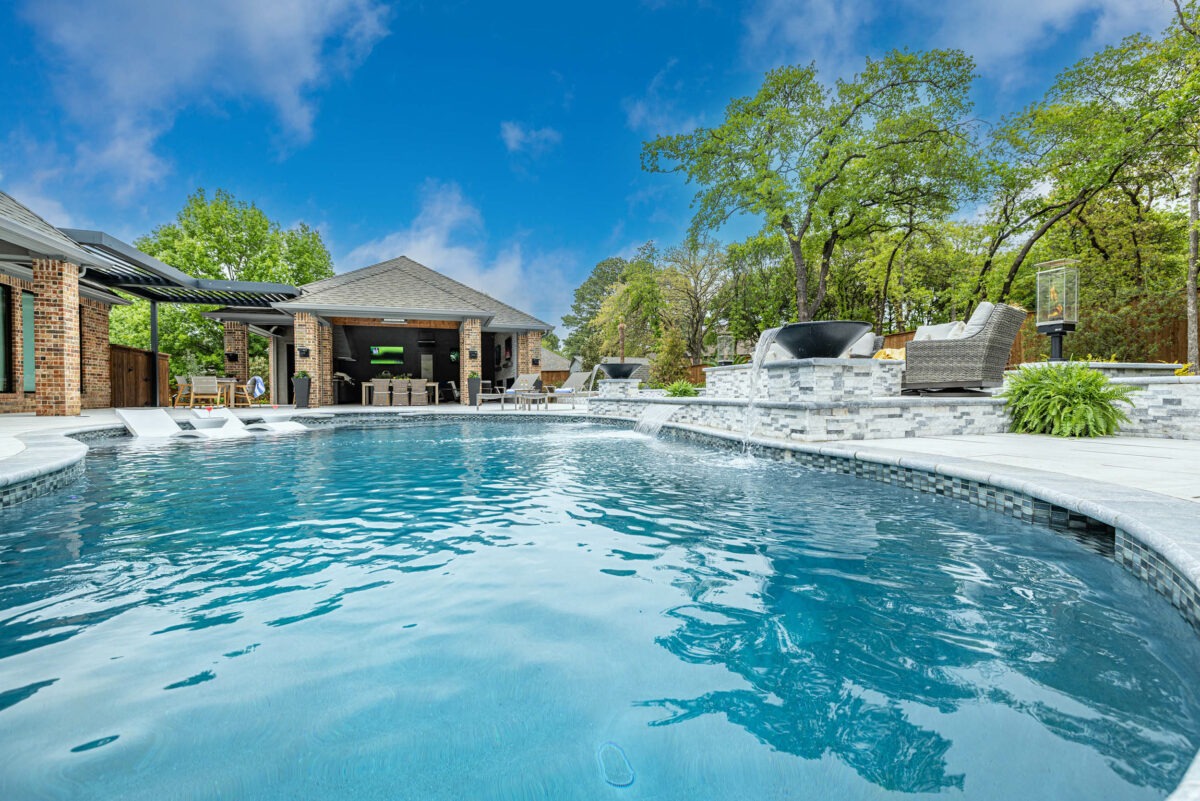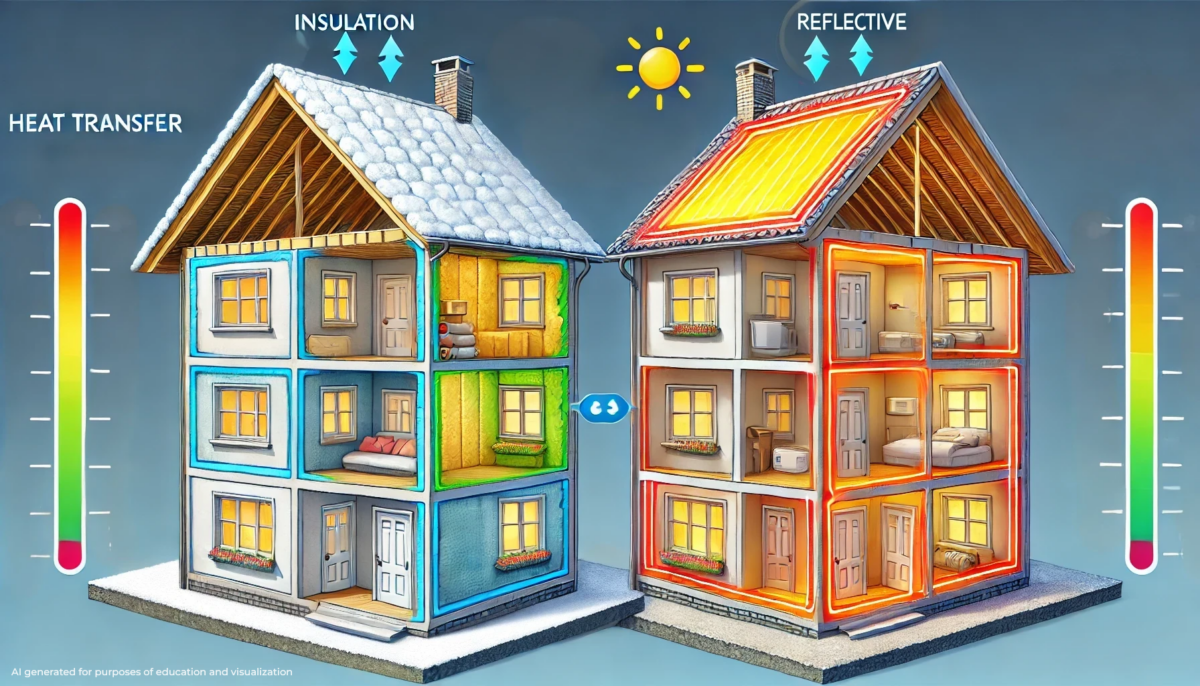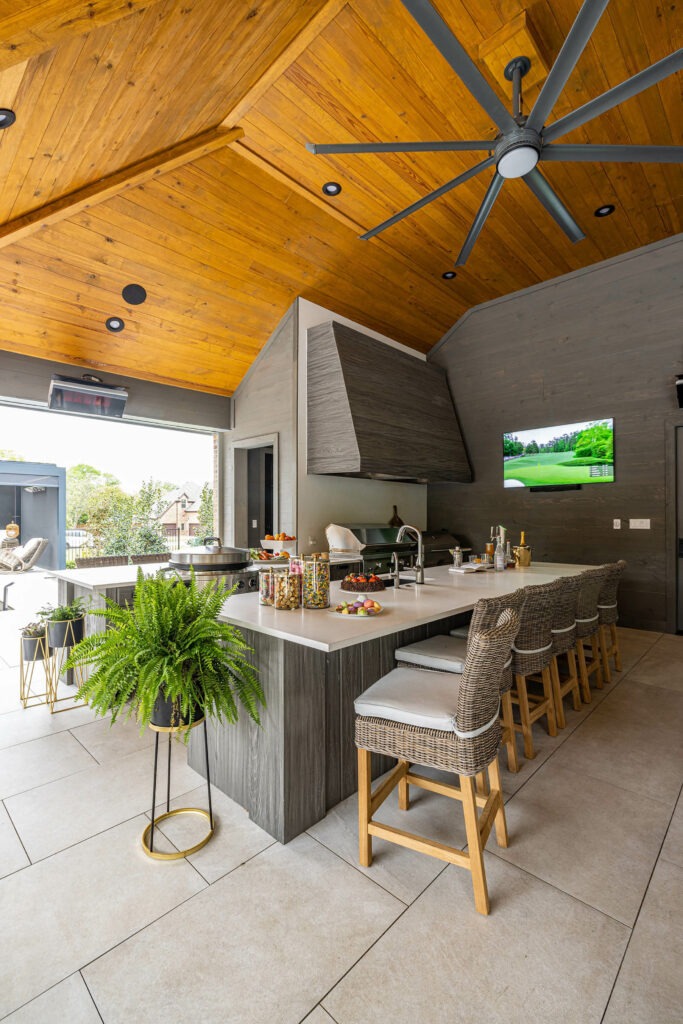It’s early July in Westlake, Texas. The sun is beating down, making the air outside thick and sticky. You open the door, and it feels like you opened the oven…
Inside one beautifully designed home, the heat is almost as UNBEARABLE. Despite the high-end finishes and luxury aesthetic, the homeowner is sweating in the living room. With the large windows and spacious rooms, the home is trapping heat inside instead of keeping it at bay!!
This home is gorgeous, but it’s not designed for Texas heat. If only the builder or the homeowner knew what key design features could have made this affluent home a TRUE oasis…

Part 1: Home Design for a Cooler Home
To that story above, there are those who say, “the builder should have known better!”
The sad reality, though, is that the builder’s priorities won’t always be the buyer’s priorities. Besides…existing homes that were built decades ago have already been renovated several times over, so if ANYTHING was done without optimal cooling in mind, the current owner will only feel it come summertime…
Furthermore, maybe the homeowner above chose that home because of its big bay windows and natural light. How do you balance a desire like that with keeping your home cool?
These are the design features to consider…

- Window placement and orientation
Yes! You can have the great, big windows! These are one of the beautiful features of many homes in our area here in Keller, because they provide loads of natural Texas sunlight and scenic views.
However, the placement and orientation of those windows SIGNIFICANTLY impact the temperature of your home interiors.
Windows facing west will bear the brunt of the setting sun, which is far hotter than the morning sun. Any rooms facing west with lots of natural light could turn into hotboxes by late afternoon.
Why it matters: The direction that your windows face can cause rooms to overheat, requiring more energy for cooling.
Strategically placing windows and planning your layout to avoid having rooms like the living room facing west can reduce your reliance on AC quite a bit. The most-used rooms should face north and south, when possible, to offer consistent light without the intense heat of direct sunlight.
Sunlight will also mean damage to your finishes and furnishings. A room with custom furniture or lots of art on the walls will suffer fast if its windows are west-facing… - Natural airflow and ventilation
The way air flows naturallythrough your home can make a huge difference in your environment, too. Homes designed with open floor plans and strategically placed windows and vents will enhance natural airflow, reducing the need for air conditioning.
Why it matters: Ventilation is what moves warm air out and introduces cooler air. Favoring floorplans that enhance natural airflow will lower cooling costs and keep cool air floating through.
Can you imagine a fresh breeze rolling across your face and neck right now?…Yes, because it’s truly Texas-hot out this weekend!!
For this effect, designs that promote cross-ventilation are ideal, where windows and doors are placed opposite each other to allow a breeze to pass through… - Ceiling height
High ceilings can be good and bad in home design, just like those big, bay windows…
For the aesthetic of your home, high ceilings add grandeur. They’re truly exquisite, especially with the right ceiling trim.
…But they can also affect your home’s temperature.
Why it matters: heat rises, so high ceilings can trap hot air above the living space. By simply incorporating ceiling fans (or designing with lower ceilings in critical areas), you can help maintain a cooler environment.
By combining higher windows with higher ceilings, you can also encourage air movement out by opening the windows (when the weather allows). - Insulation and roofing materials
The insulation and materials used in your roof’s construction play a critical role in regulating your home’s temperature. Proper insulation doesn’t just keep the cold out…it keeps the cool air in and the hot air out during the summer, too!
Also, your choice of roofing materials will either reflect OR absorb heat. Which do you think you want in Fort Worth?!
Why it matters: the right choice of roofing materials PLUS proper insulation will reduce “heat gain” from your roof, which keeps your whole home cooler. Insulation in the attic and throughout the rest of your exterior walls will keep heat from radiating down into your living area.
Here are the common roofing materials used in Texas…which do you have on your roof?!
| HOTTER MATERIALS (absorb heat) | Asphalt shingles | Clay tiles | Unpainted metal roofs | Dark-colored metal roofs |
| COOLER MATERIALS (reflect heat) | “Cool roofs” (coated) | Concrete tiles | Slate | Solar reflective shingles |

Part 2: Home System Features for a Cooler Home
Other than your home’s design…your HOME SYSTEMS are the gateway to a cool summer or an uncomfortable one!!
Here are the systems that factor into your home environment…

- HVAC (obviously)
The Heating, Ventilation, and Air Conditioning system is the heart of your home’s climate control.
Whether your system is in tip-top condition or not is what ultimately decides how comfortable you are this summer.
Why it matters: an outdated or inefficient HVAC system will struggle to keep up with North Texas cooling demands…which means higher energy consumption and costs for you.
Prioritize getting regular maintenance and upgrading to a smart thermostat for better control and efficiency, if you haven’t already. - Bathroom ventilation
Bathrooms are a stifling source of heat AND humidity, especially after showers. Ventilation is crucial to expel that warm, moist air.
Why it matters: poor bathroom ventilation will increase your overall indoor humidity levels, making the whole home feel warmer.
If you have or want a health-focused steam shower, too, ventilation is what makes that possible.
Installing the right bathroom exhaust fans in the right places remove hot and humid air. If you find the fan noise obnoxious, there’s a solution for that!! Fan motors can be installed high up in the attic to give you a nearly silent ventilation system for your bathroom. - Kitchen ventilation
Kitchens are another MAJOR heat source in your home. A good range hood, though, can reduce the heat AND steam AND fumes released into the home, keeping it cooler (and significantly cleaner).
Why it matters: cooking is the principal source of heat in your home, raising the temperature in every room. A high-quality range hood can extract all that heat, keeping the kitchen and surrounding areas cooler…while also reducing the need for added AC.
The best part? Oven hoods are the EYE-CANDY of a custom kitchen now, with truly exquisite designs to choose from among the high-end manufacturers!!
See what I fell in love with at High Point Market this spring, for example… - Window materials and window treatments
The materials used for windows and especially your window treatments also affect how much heat is transferred into your home.
For starters…double-glazed windows and UV-reflective coatings reduce heat gain by quite a bit.
The more fun side of things, though, is seen in window coverings. There are more custom options to choose from than EVER before with a brand like Graber Blinds. With remote control lifts and every level of light control, all customizable to your aesthetic, protecting your interiors has truly never been easier (or more fun to design).
We’re Graber dealers, and can customize your window treatments and order for you…this is part of our interior design services.
Why it matters: windows are the greatest source of heat gain in a sunny climate like Texas. Upgrading your windows or upgrading your window treatments will instantly lower indoor temperatures and your energy costs.

A Checklist for Anyone Buying or Renovating a Home…
If you’re in the market to buy a home OR are planning a renovation, staying cool should be top of mind in Tarrant County!!
Use this checklist to evaluate and prioritize the design of any home you want to buy, OR the design you’re thinking of incorporating into your home with a custom renovation.
- Window placement and orientation:
- Check the directions windows face in key rooms
- Look for shading options that could be added (trees, awnings)
- Natural airflow
- Assess the floor plan for natural ventilation opportunities
- Look for features that promote cross-ventilation
- Ceiling height and ceiling fans
- Consider the height of key living spaces, especially with west-facing windows
- Consider installing ceiling fans in high-ceiling rooms
- Insulation and roofing materials
- Check the quality and type of insulation
- Identify the roofing material
- HVAC system
- Evaluate the age and efficiency of the HVAC system
- Consider a smart thermostat, if one isn’t already installed
- Bathroom ventilation
- Ensure all bathrooms have efficient exhaust fans you’ll actually use!
- Get a home maintenance professional to check for signs of excess humidity or mold
- Kitchen ventilation
- Look for a high-quality range hood that you love
- Ensure it vents to the OUTSIDE, not just recirculating air…
- Window materials and treatments
- Check for double-glazed windows or UV coatings
- Look for insulation or reflective window treatments
- Treat yourself to the window coverings with remote lift to make protecting your interiors as easy as pressing a button…
Keep beating the heat — even the sweltering Texas summers. Use this information to ensure you keep loving your home by making it the comfortable refuge you can’t wait to come home to.
For some added inspiration…take a look at an indoor-outdoor oasis with this award-winning, custom pool cabana…talk about a way to stay cool and enhance your lifestyle!!


Questions? Observations about your own home? Start the conversation with our team to discuss…
About the author

Robin Burrill, RID, NCIDQ, ASID, IDS, CAPS, is an award-winning professional kitchen, bath, and interior designer. Robin and her husband, Robert Mathews, have owned Signature Home Services, Inc. for nearly three decades, establishing a superior in-house team with a widespread reputation for delivering meticulous design to their many repeat clients.
In 2022, the national publication, Kitchen and Bath Design News magazine, named Robin to their Top Innovator list in recognition of her achievements in the field of kitchen and bath design. In 2024, she was named one of the Fall 2024 Market Pros and “tastemakers” by ANDMORE at High Point Market. Also in 2024, Fixr identified her as one of the Top Professional Interior Designers for their nationwide audience. Over her extensive career, Robin has been quoted in Architectural Digest and Forbes multiple times; her design work has been featured in top national trade publications; and she has been interviewed for Designers Today magazine’s “Profiles in Design” video series, among others. Widely respected for the depth of her knowledge, Robin is a sought after speaker and judge for many design industry events.
In 2023, Robin designed a bench for Charleston Forge, making her foray into product design. Robin currently serves as a volunteer on the board of the Dallas/Ft. Worth chapter of the Interior Design Society.

